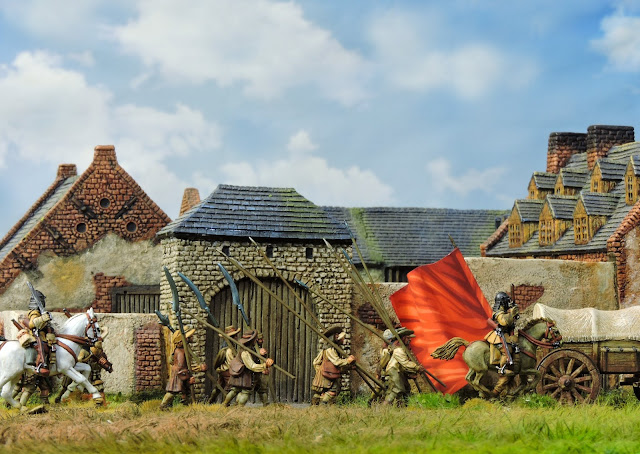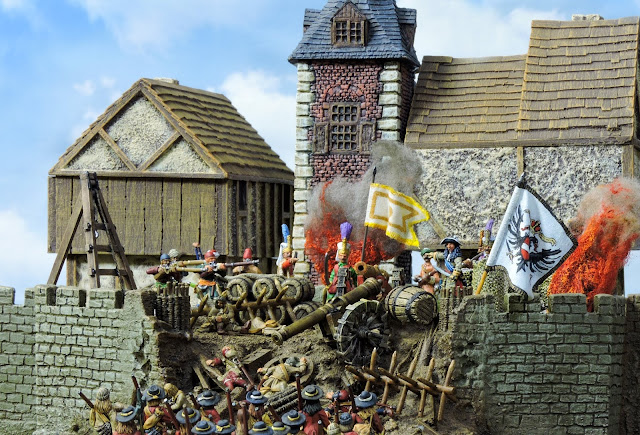This article appeared in issue #379 May 2019 or Wargames Illustrated. I am publishing it on the blog in three parts as it is fairly long.
An appraisal
of England’s fire eating general
 |
| John Cutts painted by Wissing around 1687, aged about 24 |
Like many notable men of his era, John Cutts is difficult to
define in terms of good or bad, wrong or right. If considered only by his
military deeds it is easy to be seduced and never get beyond the evocative sobriquet
of Salamander - the man who can be found where the action is hottest and the
danger most parlous. For wargamers, this may be enough. A Hector on the field
of battle with more tales to tell in a single life than many others combined.
Job done.
Read about his political career and the portrait loses some
of its lustre. Driven by chronic financial problems, the story of a
wheeler-dealer, schemer, and petitioner involved in countless intrigues emerges
to cast shadow across a previously sunlit vista. A hero who became the subject
of Swiftian satire and the butt of irreverent remarks which question not only
his integrity but also his intelligence removes further burnish and drags him
back into the mire where most lesser-mortals dwell. What should we make of this
man whose martial endeavours tower above the majority of his contemporaries?
John Cutts died at the age of 48. The truly astonishing aspect
of this fact is how he managed to live so long. Between his twenty fifth and forty
fifth years, he was seriously wounded four times and fought in some of the most
bloody and famous actions of his day. Being present at a battle is no guarantee
of being in harm’s way but in an age when general officer casualties were
proportionately very high, Cutts participated in more attacks than almost any
other officer about whom information is commonly available.
He was born in 1661 in Essex to a
landed family with property in Arkesden and Cambridgeshire. By the age of 19 he
was associating with supporters of the Duke of Monmouth in London. He followed
Monmouth into exile in Holland in 1684 but is thought not to have taken part in
the failed rebellion of 1685.
 |
| What part if any, did he play in the 1685 Sedgemoor Rebellion - history says moral support only. |
Military career
His military career probably began
on the advice of Willem of Orange in 1685. He sought to distance himself both
by proximity and action from the fall out of association with King Monmouth. He
took service with the Duke of Lorraine in the Imperial army. His appetite for fame
was whetted at the bloody storming of Buda in 1686. Legend has it that he was
the first man to plant the imperial flag on the newly captured city’s
breastworks and his actions drew both attention and reward. In 1687 he
campaigned in Transylvania and thus accrued considerable experience fighting
the Ottomans.
Driven by devotion to the Protestant religion, he was reluctant to take service with the army of King James II back in England. Instead, he chose to serve the Dutch Republic and accepted a lieutenant-colonelcy with an English regiment in Dutch service which travelled as part of Willem’s invasion army in 1688. He distinguished himself at the Battle of the Boyne and was badly wounded in the breach at the first siege of Limerick in 1690. At the end of that year he received an Irish peerage as Baron Cutts of Gowran and was a made full-colonel commanding his regiment now transferred from the Anglo-Dutch brigade to the English Establishment. He fought at Bloody Aughrim and the second siege of Limerick in 1691.
 |
| First man into Buda? Cutts has this notable claim to fame which began his climb to military stardom |
Driven by devotion to the Protestant religion, he was reluctant to take service with the army of King James II back in England. Instead, he chose to serve the Dutch Republic and accepted a lieutenant-colonelcy with an English regiment in Dutch service which travelled as part of Willem’s invasion army in 1688. He distinguished himself at the Battle of the Boyne and was badly wounded in the breach at the first siege of Limerick in 1690. At the end of that year he received an Irish peerage as Baron Cutts of Gowran and was a made full-colonel commanding his regiment now transferred from the Anglo-Dutch brigade to the English Establishment. He fought at Bloody Aughrim and the second siege of Limerick in 1691.
 |
| On to Limerick! The bold John leads his Protestant boys toward the cauldron of the 1690 siege. |
He moved with most of the army to
Flanders and at Steinkirke on August 3, 1692 was wounded during heavy fighting.
In March 1693 he was promoted brigadier-general. With his regiment, he may have
fought at Neerwinden in 1693 and was present with the battalion during the
abortive all- English attack at Camaret Bay in 1694. Parliamentary papers say
he was charged with disobeying orders there. He became colonel of the
Coldstream Guards on the demise of Thomas Tollemache who died commanding the
Camaret expedition. Tollemache was responsible for the accusation of Cutts’ disobedience
just before his own death. Cutts led an assault and distinguished himself at
the British Army’s first victory - storming the citadel of Namur in 1695. He
received a musket ball to the head for his pains and the first use of the
nickname Salamander appeared at this time.
He returned to military service in
1701 under Marlborough and went to Flanders once more. He led an attack which
captured an outwork at the siege of Venlo in September 1702. In February 1703
he was promoted to lieutenant-general. His final battle was Blenheim, August
13, 1704 at which he commanded a considerable body of troops some of which
attacked Blindheim itself. In March 1705 he was made commander of the army in
Ireland and saw no further active service.
In Part 2 we'll focus on his deeds and character and some of the public response to his military reputation.
In Part 2 we'll focus on his deeds and character and some of the public response to his military reputation.
